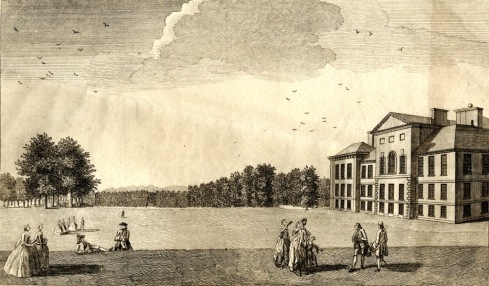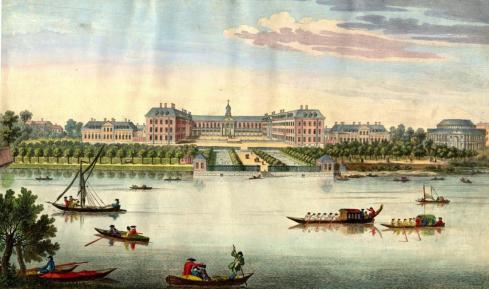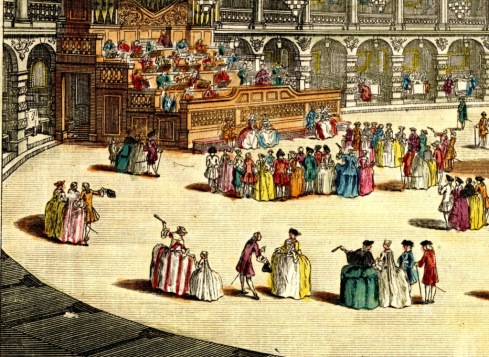Before the photograph came the engraved print: etchings, mezzotints, aquatints and all the rest. These were on the whole meant to be accurate views of their subjects, reliable likenesses of a person or a building. But it’s not quite the same as a photograph, is it? Looking at last week’s picture postcards I thought of the earlier, pre-photographic views of Kensington Gardens and of course Kensington Palace. Here’s a good example:
As is often the case the architectural view was enlivened by the addition of some figures. We know that the ladies and gentlemen of 18th century society entertained themselves by walking around in fashionable places, taking a look at their friends and acquaintances and being seen by them in turn. So the view of this happy crowd, walking, talking and even sitting is not actually unlikely, there’s just something a little staged about it. These people are like extras milling around the star of the picture – the Palace. I imagine them biding their time, waiting to see if they could get a piece of the action for themselves.
What is the persuasive looking gentleman in the group on the right saying to his companions? Is he asking them to join him on an expedition into the Palace? Are the seated group ready to watch them?
This is another view of the Palace:
Another idle group wave fans, greet each other or lounge on the ground which can’t have done much for their fine clothes. Compare them with this group:
The Palace and the trees across the lawn are almost identical. Another group of slightly better rendered visitors have wondered into shot. Remember etching is hard work. It’s not pen and paper, it’s scratching the image on a sheet of metal, in reverse. (I simplfy a complex and multifarious process – experts please forgive me) If the background is the same and you can enliven the view with a different cast so much the better.
I do find these people fascinating though especially the women sweeping across the grass in their strange wide skirts. The period is slightly wrong but it puts me in mind of the Draughtsman’s Contract where a mystery is suggested by drawings of a house and garden but never solved by its protagonist. The Draughtman in the film would have appreciated this view:
Here the Palace is reduced to a feature in the distance with our attention occupied by a section of the Serpentine and the Queen’s Temple across the water. One of those follies loved by aristocrats and landscapers seen in many country estates, it would have been ideal for one of the Draughtman’s assignations.
In this one some actual gardening is going on at the right of the picture. The strollers ignore the workers though, and we ignore them in favour of the frantic activity by the birds in the foreground. A fight on the left? An attempt to take off on the right?
If we pull out and take a wide view of the Palace we get something like this:
The pattern of the ornamental garden is revealed and the picture looks more like a plan but it’s still full of those figures wandering around. Last year at Marienbad,anyone? (I’m taking a stab in the dark there – I’ve never actually seen the film but one of the famous images from it is a large ornamental garden). The feature that always strikes me is that the Palace is set in what appears to be an empty landscape with no sign of London. Those distant hills are the etcher’s equivalent of stock footage. Or maybe I’m missing some convention of this kind of picture.
One of the conventions is the idealised landscape. Here’s one:
A solitary figure looks back at his house, his lake, his cattle and his picturesque crumbling “priory”, specially built as a ruin as was the custom of ambitious land owners. The Pavilion, the building in the distance was constructed by Henry Holland in 1789 and survived into the 19th century as Chelsea grew around it and the grounds had their final incarnation as a cricket ground. (That’s a story for another day if ever I heard one). But nothing could stop the growth of the Cadogan Estate. (To orientate yourself I think Sloane Street runs a little to the right of the Pavilion which gave its name of course to Pavilion Road) I can’t help thinking that even before development the grounds were not as extensive as they appear in this view. (The Pavillion survived until 1874 when it was demolished to make way for Cadogan Square and its surrounding streets)
Further south we’re on safer ground. As Kensington has its Palace, Chelsea has the Royal Hospital:
Here too the landscape is crowded. The main focus of activity is the variety of craft going to and fr,o some speedy and some slow. In the distance people walk in the grounds, perhaps heading for that other fashionable rendezvous point the Rotunda.
Inside the ladies and the gentlemen parade around or take refreshment by the big fire. Look closely:
More bowing and gesturing with fans. A sizeable group listens to the orchestra.
There are a couple more instances of the fan gesture in this detail. In some ways these figures repeat themselves at the whim of the artist. At other points they show a life of their own. Look at the woman in the group of three between the child and the woman in green, how she leans back slightly to whisper in her friend’s ear. A small number of lines suggest this recognizeable movement.
Inside the world of the print the inhabitants live their lives.
Here a group of them pay a visit to the Chelsea Waterworks, enough of a technological marvel to warrant some early tourism.
Further down the river in Battersea others come and go at a jetty.
In the distant background you can see Chelsea Old Church with its cupola. On the shore a woman, her son and their dog get ready to board, a servant carries their bag:
The group of three women and a man on the right meet up with a man who points their way out of the picture all together. Perhaps all these decorative figures in the idealised landscapes of the etching are looking for a way out.
Postscript
The Chelsea art collection was recently moved to Kensington Library making it easier for me to find pictures like the last two. During my search I came across an image I found quite startling which might form the basis of a future post if I can find some more like it. Watch out for that. If you’ve never seen the Draughtsman’s Contract it’s worth a look. Just don’t expect a solution to the mystery (if there was one).



















July 30th, 2019 at 1:46 am
In the ‘Marienbad’ picture you aren’t missing anything, or anything much, in the background. Kensington Palace was then in open country of fields and market gardens, well to the west of London. The picture looks north, so London would have been out of frame on the right side. Kensington village would have been out of frame on the left.